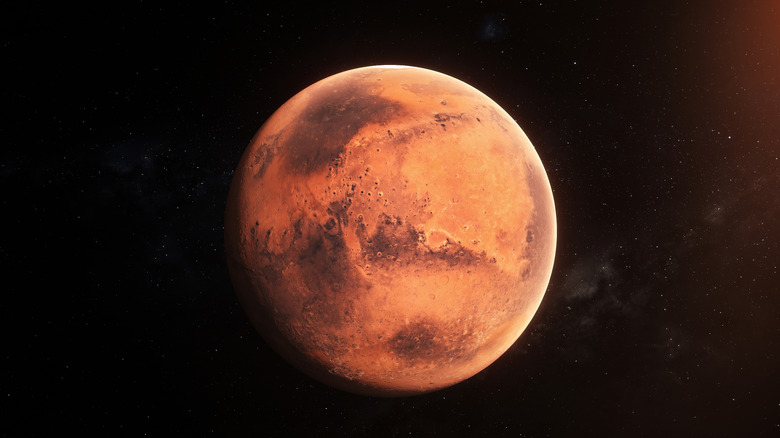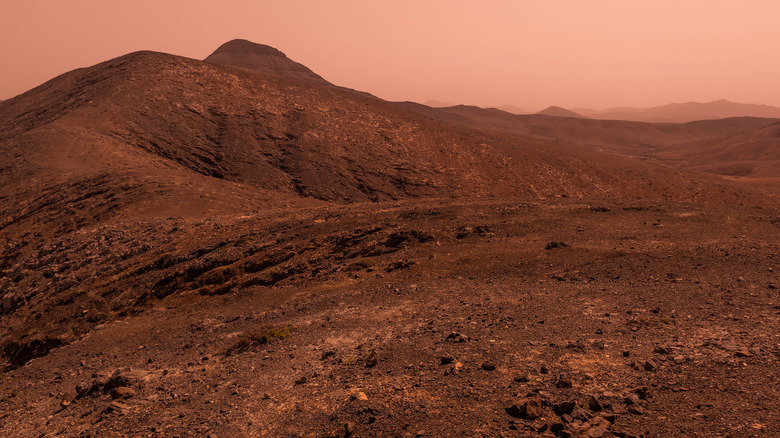An Unassuming Rock Found In Indiana Proves There Was Water On Mars
One day in 1929, someone opened a drawer in the biology department at Purdue University and discovered a tiny black rock inside. It measured just 5 centimeters (2 inches) in length, but weighed in at 800 grams, close to 2 pounds. Nobody at the University knew what it was or where it came from.
For five long decades, the little black rock sat shrouded in mystery, until the 1980s, when a research team performed an analysis on gasses trapped within the mineral. They found that the gasses did not match the makeup of Earth's atmosphere, but rather that of Mars, revealing that the little rock was in fact a meteorite from the red planet. It was dubbed the Lafayette Meteorite as a nod to the town in Indiana where Purdue University is based, and to this day, it continues to transform our knowledge of Mars.
It's not news that there was once water on Mars. In fact, there still is, as Mars is one of the planets with polar ice caps, which are largely composed of frozen water. However, it has long been believed that liquid water vanished from Mars at least two billion years ago. A recent study on the Lafayette Meteorite has thrown this assumption into question. In November 2024, researchers from Purdue published a study in the journal Geochemical Perspectives Letters, which showed that the minerals in the meteorite had been in contact with liquid water roughly 742 million years ago, much later than any other evidence of liquid water on Mars.
How recently was there liquid water on mars?
The Lafayette Meteorite was found to contain certain minerals that form through reactions with liquid water, but that doesn't mean we have to scrap all our previous assumptions about water on Mars. The red planet's hydrologic history first came to light in 1971, when the Mariner 9 spacecraft observed signs of canals on Mars. Subsequent surveys of the planet, including NASA's Viking and Curiosity rovers, have revealed even more traces of ancient rivers and deltas.
In the early stages of Mar's life, its atmosphere was denser, preventing water from evaporating and escaping the planet. However, solar winds and ultraviolet radiation from the sun stripped away much of the atmosphere, leaving Mars barren. Today, the planet's surface temperature averages around negative 80 degrees Fahrenheit, too cold for liquid water to exist. Mars does hold frozen water in its polar ice caps, but it is locked in a state of permafrost beneath a layer of frozen carbon dioxide.
How could the Lafayette Meteorite hold traces of liquid water when Mars had dried up hundreds of millions of years before its formation? Marissa Tremblay, who led the Purdue study, believes that the traces of liquid water came from permafrost which melted due to magma flowing on Mars's surface. This affirms the belief that the oceans and rivers of Mars dried up over two billion years ago but suggests that small amounts of liquid water may still flow periodically.
How did the Lafayette Meteorite get from Mars to Indiana?
The Lafayette Meteorite has given answers to one of Mars's greatest mysteries, but the history of the little black rock is just as perplexing. It likely began as a piece of debris ejected from Mars after an asteroid impact. For over 10 million years, it floated around in space before ultimately crashing into Earth, which is where the real mystery began.
Nobody knows for certain how the meteorite ended up in that drawer at Purdue. There's even some confusion over its date of discovery, with many reports claiming it was found in 1931, despite the University itself placing the finding in 1929. Meteorologist Harvey Nininger wrote a paper in 1935 that includes an anecdote about a Black student who witnessed the Lafayette Meteorite fall and brought it to the school.
Meteor showers in the vicinity of Purdue had been reported in both 1919 and 1927. Records of Purdue enrollment from those years reveals four Black students — Hermanze Edwin Fauntleroy, Clinton Edward Shaw, and Julius Lee Morgan (all enrolled in 1919), plus Clyde Silance (enrolled in 1927) — who could have fit Nininger's anecdote. Further evidence came in 2019, when researchers identified traces of a fungus that grows on corn in the Lafayette Meteorite. A particularly bad outbreak of that fungus had occurred in 1919, suggesting that either Fauntleroy, Shaw, or Morgan was the one who made this game-changing discovery.


